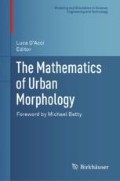Abstract
Mathematics is essential in a formal treatment of urban morphology because the complexity of urban form is best represented as a mathematical object, a fractal. Mathematics is equally important in models of morphogenesis. Nevertheless, mathematics in itself is incapable of representing morphogenetic processes and must be embedded in algorithms in order to capture the temporality of morphogenesis. In the case of straightforward processes of urban self-organisation, conventional simulation models are sufficient. However to capture the creativity of cities—their ability to create new agents and new types of agents with new rules of behaviour—unconventional algorithms are required, algorithms that alter themselves during execution. Ultimately algorithms, not mathematics, provide the natural language of morphogenesis.
Access this chapter
Tax calculation will be finalised at checkout
Purchases are for personal use only
References
Alonso, W. 1964. Location and Land Use: Toward a General Theory of Land Rent. Cambridge, MA: Harvard University Press.
Angel, S. and Hyman, G. 1976. Urban Fields: A Geometry of Movement for Regional Science. London: Pion Press.
Batty, M. and Longley, P. 1994. Fractal Cities: A Geometry of Form and Function. Academic Press.
Bettencourt, L. 2013. “The Origins of Scaling in Cities.” Science, vol. 340, pp. 1438–1441.
Caruso, G., Peeters, D., Cavailhès, J. and Rounsevell, M. 2007. “Spatial Configurations in a Periurban City: A Cellular Automata-Based Microeconomic Model”. Regional Science and Urban Economics, vol. 37, pp. 542–567.
Frankhauser, P. 1994. La Fractilité des structures urbaines. Paris: Anthropos.
Fujita, M. 1989. Urban Economic Theory: Land Use and City Size. Cambridge: Cambridge University Press.
Muth, R. 1969. Cities and Housing: The Spatial Pattern of Urban Residential Land Use. Chicago: University of Chicago Press.
Papageorgiou, Y. 1990. The Isolated City State: An Economic Geography of Urban Spatial Structure. London & New York: Routledge. 466 pp.
Prigogine, I. and Stengers, I. 1984. Order out of Chaos: Man’s New Dialogue with Nature. New York: Bantam Books.
Rosen, R. 1991. Life Itself: A Comprehensive Inquiry into the Nature, Origin, and Fabrication of Life. New York NY: Columbia University Press.
Straatman, B., White, R. and Banzhaf, W. 2008. “An Artificial Chemistry-based Model of Economies”. In Bullock, S., Noble, J., Watson, R. and Bedau, M., eds.: Artificial Life XI: Proceedings of the Eleventh International Conference on the Simulation and Synthesis of Living Systems. Cambridge, MA: MIT Press, pp. 592–599.
Thomas, I., Frankhauser, P. and Biernacki, C. 2008. “ The Morphology of Built-Up Landscapes in Wallonia (Belgium): A Classification Using Fractal Indices”. Landscape and Urban Planning, vol. 84, pp. 99–115.
West, G. 2017. Scale: The Universal Laws of Growth, Innovation, Sustainability, and the Pace of Life in Organisms, Cities, Economies, and Companies. Penguin Press.
White, R. 1977. “Dynamic Central Place Theory: Results of a Simulation Approach”. Geographical Analysis, vol. 9, pp. 226–243.
White, R. and Banzhaf, W. 2019. “Putting Natural Time into Science”. In A. Adamatzky and V. Kendon (eds) From Astrophysics to Unconventional Computing: Essays presented to Susan Stepney on the occasion of her 60th birthday. Springer (in press).
White, R., Engelen, G. and Uljee, I. 2015. Modelling Cities and Regions as Complex Systems: From Theory to Planning Applications. Cambridge, MA: MIT Press.
Author information
Authors and Affiliations
Corresponding author
Editor information
Editors and Affiliations
Rights and permissions
Copyright information
© 2019 Springer Nature Switzerland AG
About this chapter
Cite this chapter
White, R. (2019). Urban Morphogenesis: Putting Mathematics in Its Place. In: D'Acci, L. (eds) The Mathematics of Urban Morphology. Modeling and Simulation in Science, Engineering and Technology. Birkhäuser, Cham. https://doi.org/10.1007/978-3-030-12381-9_22
Download citation
DOI: https://doi.org/10.1007/978-3-030-12381-9_22
Published:
Publisher Name: Birkhäuser, Cham
Print ISBN: 978-3-030-12380-2
Online ISBN: 978-3-030-12381-9
eBook Packages: Mathematics and StatisticsMathematics and Statistics (R0)

